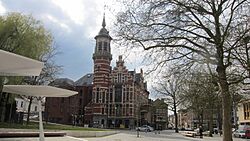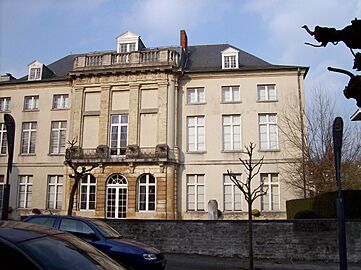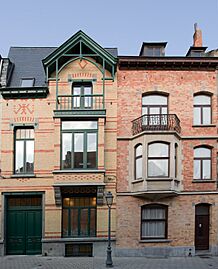Jette facts for kids
Quick facts for kids
Jette
|
|||
|---|---|---|---|

Jette's Municipal Hall
|
|||
|
|||
| Country | Belgium | ||
| Community | Flemish Community French Community |
||
| Region | Brussels | ||
| Arrondissement | Brussels-Capital | ||
| Area | |||
| • Total | 5.04 km2 (1.95 sq mi) | ||
| Population
(2018-01-01)Lua error in Module:Wd at line 1575: attempt to index field 'wikibase' (a nil value).
|
|||
| • Total | Lua error in Module:Wd at line 1,575: attempt to index field 'wikibase' (a nil value). | ||
| Postal codes |
1090
|
||
| Area codes | 02 | ||
| Website | jette.irisnet.be/en jette.irisnet.be/fr jette.irisnet.be/nl |
||
Jette (French: [ʒɛt], Dutch: [ˈjɛtə]) is one of the 19 towns that make up the Brussels-Capital Region in Belgium. It's located in the northwest part of this region. Jette shares its borders with other towns like the City of Brussels, Ganshoren, Koekelberg, and Molenbeek-Saint-Jean. It also touches the Flemish towns of Asse and Wemmel. Like all towns in Brussels, Jette uses both French and Dutch languages officially.
As of 1 January 2022[update], about 52,751 people live in Jette. The town covers an area of 5.19 square kilometers (about 2 square miles). This means it's quite densely populated, with around 10,165 people per square kilometer.
Contents
History of Jette
Early Settlements to the Middle Ages
People have lived in the area of Jette for a very long time. Tools from the Neolithic period (the New Stone Age) have been found here. Also, remains of a large Roman house show that people lived here during the time of the Gallo-Roman Empire. The first church in Jette was named after Saint Peter. This suggests that Christianity arrived in the area quite early.
During the Middle Ages, some parts of Jette were under the control of the Duchy of Brabant. This was a powerful area ruled by a duke. In 1095, a special religious community called Dieleghem Abbey was started in Jette. It was founded by the Bishop of Cambrai and run by Augustinian priests. Later, in 1140, the monks at the Abbey changed their rules to follow the Premonstratensian order. By the 1200s, the Abbey owned half of Jette's land. It played a very important role in the town's social and economic life until the French Revolution.
From the 17th to the 20th Century
Before the French Revolution, during a time known as the Ancien Régime, Jette was part of a nearby town called Merchtem. In the 1600s, when the Spanish Netherlands ruled the area, a finance minister bought and fixed up an old castle near Jette. This castle was called Rivieren Castle. In 1654, the minister's son made this estate into a barony. Five years later, it became a county, which included Jette and several other villages.
In the 1790s, the French Revolution brought big changes. The new government greatly limited religious freedoms. The monks were forced to leave Dieleghem Abbey in 1796. Most of the Abbey buildings were torn down the next year. Only the abbot's house was saved and used as a leisure home. In 1841, the town of Ganshoren separated from Jette. Over the next few decades, Jette slowly changed from a rural area with farms into a suburb of Brussels. Its population grew a lot, from about 10,000 people in 1900 to more than 40,000 in 1971.
Places to See in Jette
Jette has many interesting places to visit.
- The Municipal Hall of Jette is the town's main government building. It was designed by architect Jules Van Ysendyck and built in the early 1900s.
- The abbot's mansion is the only building left from the old Dieleghem Abbey. Today, it is a museum that mostly focuses on history.
- Jette still has some of its old pubs and breweries. There's also a blacksmith's workshop that was used until 1960.
- The René Magritte Museum is located in the house where the famous painter René Magritte lived and worked for 24 years. He was known for his surrealist art.
- The Vrije Universiteit Brussel (VUB) is a Dutch-speaking university in Brussels. Its hospital and medical campus are located in Jette.
- The Jette railway station opened in 1892. It is located near King Baudouin Park.
Famous People from Jette
Several well-known people have lived in or come from Jette:
- Thomas Chatelle (born 1981), a professional football player.
- Rik Coolsaet (born 1951), a Professor of International Relations at Ghent University.
- Jason Denayer (born 1995), another professional football player.
- Eric Ghysels (born 1956), an economist.
- René Magritte (1898–1967), a famous surrealist painter.
- François Narmon (born 1934), a businessman who was born in Jette.
- Jean Roba (1930–2006), a comic book author who created the popular comic series Boule et Bill.
International Connections
Jette has special connections with towns in other countries. These are called twin towns or sister cities. They often share cultural exchanges and friendships. Jette is twinned with:
 Sidi Bibi, Morocco
Sidi Bibi, Morocco Jojutla, Mexico
Jojutla, Mexico
See also
 In Spanish: Jette para niños
In Spanish: Jette para niños








